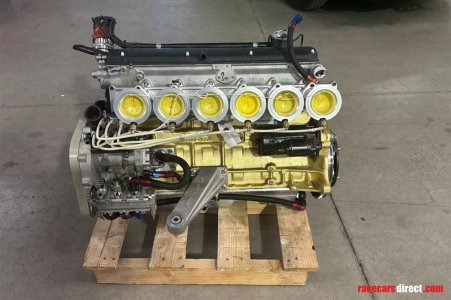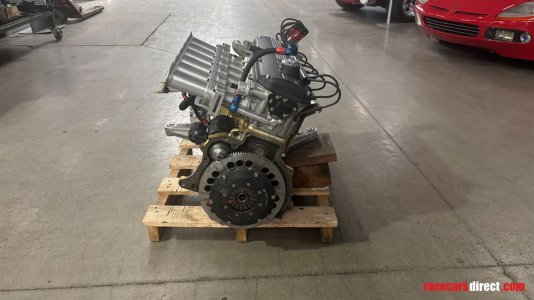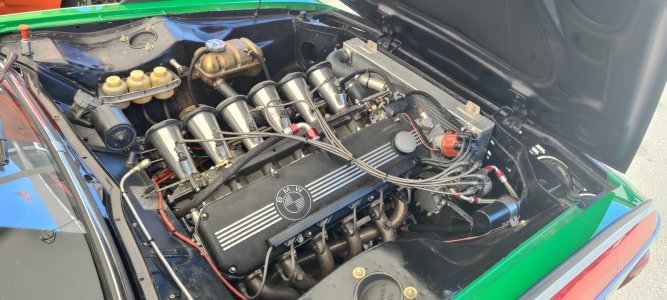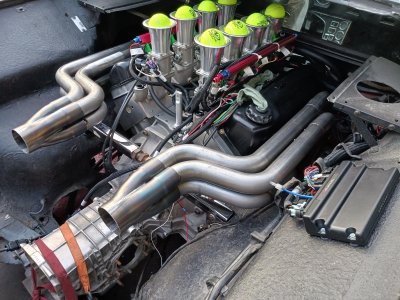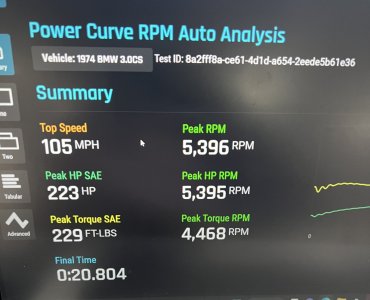“not a civilized car” Yep! That’s my M90 Euro. All business, but not particularly comfortable or easy to drive!while i haven't tested the various 6ers ... i had direct comparisons with a 2002 with a Korman stage 3+ engine and an e30 m3 - so the comparison of a lighter car - a highly tweaked m10 with twin 45 dcoes + 5 speed - total Korman built car against the great e30 m3 with the s14 (2.3L). both cars made all of their power above 3500 rpm. because the m10 had a schrick 316 cam and was 10.5:1 or 11:1 (i don't remember) and produced 185 hp (according to Korman), when you crossed 3500, you were at redline pretty quick and as long as you downshifted going into turns you could accelerate like no tomorrow. it was NOT a civilized car, but it was fast + brutal - the suspension was a bit stiff. by comparison, the m3 was civilized and beautiful, the s14 is a gorgeous engine - neither of these engines compared to the smooth beauty of a tii engine, but they were a lot faster. if i was to get another 2002, it would be a tii or a rebuilt engine with 150 to 170 hp and gain the low end torque -- or -- the 2002 with a S14 engine and 200 hp
You are using an out of date browser. It may not display this or other websites correctly.
You should upgrade or use an alternative browser.
You should upgrade or use an alternative browser.
What's the best 3.5L block + head combo?
- Thread starter yellowbullet
- Start date
rblongboarder
Well-Known Member
My search for parts has led to a few more components that seem to fit into this discussion...
Schaper Automotive, a German firm that makes a dry sump kit for the M30 & S38 motors:

 www.schaper-automotive.com
www.schaper-automotive.com
Schaper also makes a M30 block girdle which goes between the block and oil pan:

 www.schaper-automotive.com
www.schaper-automotive.com
Schaper also makes engines...

 www.schaper-automotive.com
www.schaper-automotive.com
Schaper Automotive, a German firm that makes a dry sump kit for the M30 & S38 motors:

Dry sump kit BMW S38 | 39101
Dry sump kit BMW M30, M106, M88 and S38 Consists of: 4-stage oil pump Peterson 04-4020 position right Pump wheel HTD 44 teeth Output gear HTD 22 teeth with adapter for the ATI Damper Drive belt HTD Pump holder 3x Inline Filter AN…
Schaper also makes a M30 block girdle which goes between the block and oil pan:

M30/S38 block girdle | 22101
M30/S38 block girdle set Stiffening plate made of steel with ARP main bearing studs enables better distribution of forces in the bearing blocks and the entire engine block and allows very high boost pressures. A must for boost pressures from 1.5bar. ARP…
Schaper also makes engines...

Engines and components
Clubsport_CSi
Well-Known Member
I follow Eugen's work since his start in the E30 forums, he is quite established and I did not hear anything negative on his work but many positive reports. He is specialised in turbo engines, though (at least to the best of my knowledge).
rblongboarder
Well-Known Member
@Clubsport_CSi : Thank you for your feedback! I was hoping someone from Europe would know and comment on Schaper's M30 components.
@Lucas : Do I see a Kugelfischer mechanical fuel pump on that Group 2 engine? Individual fuel lines running to each velocity stack (trumpet) ? This motor reminds me of the motor in the Luigi CSL I see at Laguna Seca Historic racing.
@Lucas : Do I see a Kugelfischer mechanical fuel pump on that Group 2 engine? Individual fuel lines running to each velocity stack (trumpet) ? This motor reminds me of the motor in the Luigi CSL I see at Laguna Seca Historic racing.
Do I see a Kugelfischer mechanical fuel pump on that Group 2 engine? Individual fuel lines running to each velocity stack (trumpet) ?
YES!
Below is the guys' response to my inquiry about the engine some time ago.
"Hello,
The engine has been completely rebuilt with new parts. The engine has just been run in. The cylinder head is from 1981, and the engine was built in 2023.
Yes, we can sell it without accessories. Do you need the mounting plate for the Kugelfisher or not?
The price of the engine without accessories is 25,000 euros."
Thx
vincent
GRC SPORT
AV DE L ESPERANCE 32
6220 FLEURUS
Belgique
MAIL: [email protected]
TEL : +32493983238
rblongboarder
Well-Known Member
Additional inspection of the GRC motor photos reveals the red & blue NPT fittings and hoses of a 3 or 4-stage dry sump oil pump just below the kugelfischer fuel pump..
The fuel injectors on this GRC motor are located in a different location than the injectors on the Luigi motor. The GRC motor has injectors at the very top of the trumpets, whereas the Luigi motor has the injectors placed at the bottom of the trumpets, where the trumpets connect to the short intake runners. (Also note the Luigi motor has the kugelfischer pump in a different location than the GRC motor...)
My friend is duplicating the Luigi fuel concept and placement in his '71 Pantera V8 motor. (He is a mechanical engineer and extraordinary machinist. He fabricated the entire exhaust system and the trumpets.) He's using MSD-controlled ignition system.. so those are EFI injectors, but their placement is quite similar to the Luigi injection locations.
Photos:
One wonders if the injector placement in the trumpet affects overall horsepower? There could be a minor affect on fuel-air mixing... hmm...
The fuel injectors on this GRC motor are located in a different location than the injectors on the Luigi motor. The GRC motor has injectors at the very top of the trumpets, whereas the Luigi motor has the injectors placed at the bottom of the trumpets, where the trumpets connect to the short intake runners. (Also note the Luigi motor has the kugelfischer pump in a different location than the GRC motor...)
My friend is duplicating the Luigi fuel concept and placement in his '71 Pantera V8 motor. (He is a mechanical engineer and extraordinary machinist. He fabricated the entire exhaust system and the trumpets.) He's using MSD-controlled ignition system.. so those are EFI injectors, but their placement is quite similar to the Luigi injection locations.
Photos:
- 1: GRC motor
- 2. GRC motor
- 3. Luigi engine bay shot
- 4 & 5: V8 Pantera motor w/ individual velocity stacks per cylinder
One wonders if the injector placement in the trumpet affects overall horsepower? There could be a minor affect on fuel-air mixing... hmm...
Attachments
Last edited:
My friend is duplicating the Luigi fuel concept and placement in his '71 Pantera V8 motor
I can only imagine what this engine sounds like. Is there a dyno graph for this engine?
This is probably one of the rarest BMW engines built and designed during the golden age of racing.
Last edited:
rblongboarder
Well-Known Member
@Lucas : we were talking about that 750hp twin turbo straight six awhile ago... remember this?
Interesting fact from 7:25 of the video.
Mechanics pack a sports turbocharged inline-6 with 800 horsepower into the engine bay of an E9 CSL designed
by Frank Stella from the BMW Art Cars series that raced in the LeMans endurance race.
Thank you for the additional video.
Interesting fact from 7:25 of the video.
Mechanics pack a sports turbocharged inline-6 with 800 horsepower into the engine bay of an E9 CSL designed
by Frank Stella from the BMW Art Cars series that raced in the LeMans endurance race.
Thank you for the additional video.
Last edited:
Having had a bit of experience now with the M88/3 in my E9 for a while now it does deliver power much different to my E24.
E24 is a barebones euro spec 86 635 with an OD 5 speed and a 3.07. Gearing is long but deceptively quick due to the wave of torque, makes motorway/continental trips a breeze. Above 5000 you can feel it starting to run out of puff though and for spirited driving a 3.25 would be much better suited.
E9 also has an OD 5 speed but with a 3.25. Below 3000 and in town the E24 definitely has the edge with usability even with it's longer gearing it doesn't need as much as a prod on the pedal. Past 4000 it starts to open up and at 5000 where on an M30 I would be looking to change it has really come on song.
What will be interesting is in the next few weeks when the standalone ecu gets fitted onto the M88 and it goes on the dyno for mapping. They've had a few and whilst peak is around 320 to 330ish bhp, there is massive shift in power and torque bringing it in much earlier with gains of 50+bhp along the plot which is what i am really interested in.
End of the day we all have our own preferences in power delivery and how we drive our cars, but it is quite hard to go wrong with whatever lump you pick!
E24 is a barebones euro spec 86 635 with an OD 5 speed and a 3.07. Gearing is long but deceptively quick due to the wave of torque, makes motorway/continental trips a breeze. Above 5000 you can feel it starting to run out of puff though and for spirited driving a 3.25 would be much better suited.
E9 also has an OD 5 speed but with a 3.25. Below 3000 and in town the E24 definitely has the edge with usability even with it's longer gearing it doesn't need as much as a prod on the pedal. Past 4000 it starts to open up and at 5000 where on an M30 I would be looking to change it has really come on song.
What will be interesting is in the next few weeks when the standalone ecu gets fitted onto the M88 and it goes on the dyno for mapping. They've had a few and whilst peak is around 320 to 330ish bhp, there is massive shift in power and torque bringing it in much earlier with gains of 50+bhp along the plot which is what i am really interested in.
End of the day we all have our own preferences in power delivery and how we drive our cars, but it is quite hard to go wrong with whatever lump you pick!
Technology is not my strong suit.
rblongboarder
Well-Known Member
Stunning. That must be an amazing E9 to drive. (And it reminds me of staring into the engine bay of my '85 Euro E24 M635.)
You have individual throttle bodies with EFI ? I think I see the throttle linkage, fuel rail and injectors right above the M-Power logo.
You have individual throttle bodies with EFI ? I think I see the throttle linkage, fuel rail and injectors right above the M-Power logo.
Correct, RB. Thanks for the kind comments. A worthy repower for all to consider. “Almost” period correct.Stunning. That must be an amazing E9 to drive. (And it reminds me of staring into the engine bay of my '85 Euro E24 M635.)lmost” period correct.
You have individual throttle bodies with EFI ? I think I see the throttle linkage, fuel rail and injectors right above the M-Power logo.


